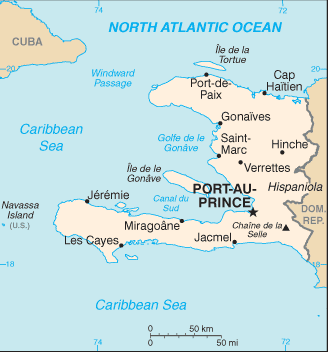 |
Mary's Rosaries |
| Home
Page Contact Us Make a Payment, Methods of Payment, Refund and Exchange Policies Rosaries subpages: How to Pray the Rosary subpages:
Pictures Main Page subpages: Curriculum subpages: Website Terms of Use License Agreement Sitemap The Work of God's Children |
 Haiti  The native Taino
Amerindians - who inhabited the island of Hispaniola when it was
discovered by Columbus in 1492 - were virtually annihilated by Spanish
settlers within 25 years. In the early 17th century, the French
established a presence on Hispaniola, and in 1697, Spain ceded to the
French the western third of the island, which later became Haiti. The
French colony, based on forestry and sugar-related industries, became
one of the wealthiest in the Caribbean, but only through the heavy
importation of African slaves and considerable environmental
degradation. In the late 18th century, Haiti's nearly half million
slaves revolted under Toussaint L'Ouverture. After a prolonged
struggle, Haiti became the first black republic to declare its
independence in 1804. After an armed rebellion led to the departure of
President Jean-Bertrand Aristide in February 2004, an interim
government took office to organize new elections under the auspices of
the United Nations Stabilization Mission in Haiti (MINUSTAH). Continued
violence and technical delays prompted repeated postponements, but
Haiti finally did inaugurate a democratically elected president and
parliament in May of 2006. French and
Creole are the official alnguages.
|
A "Safe for Souls" webpage. (this is the bottom of page) |